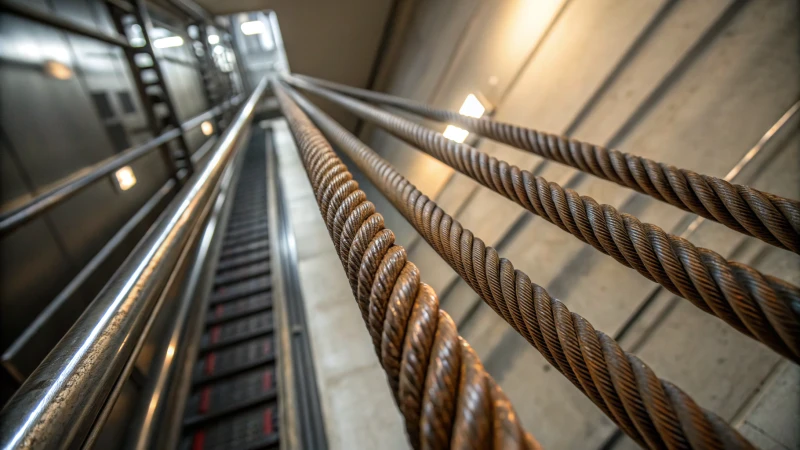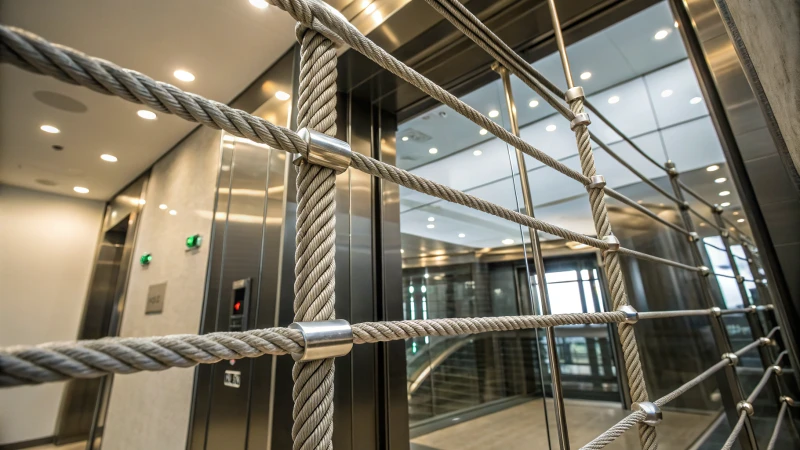
I’ve always been fascinated by how something as simple as a bit of rust can undermine the strength of steel wire ropes in elevators.
To prevent corrosion in elevator steel wire ropes, I recommend using methods like galvanization, polymer coatings, and selecting stainless steel alloys. These strategies boost resistance to rust and environmental wear, ensuring both durability and safety.
When I first started learning about these methods, I was amazed at how each technique had its unique advantages. Galvanization, for example, adds a protective zinc coating that combats rust like a superhero in a chemical battle. But in high-humidity environments, I’ve seen how polymer coatings, such as PVC or polyurethane, can really outperform, providing up to 50% better resistance compared to their galvanized counterparts. And then there’s stainless steel alloys – if you’re dealing with harsh environments where corrosion is aggressive, these are your go-to warriors. Thinking back, these choices remind me of picking the right tool for the job – each one has its place in the fight against corrosion.
Galvanization prevents corrosion in elevator steel wire ropes.True
Galvanization coats the wire with zinc, protecting it from rust.
Polymer coatings reduce the lifespan of steel wire ropes.False
Polymer coatings actually extend the lifespan by preventing rust.
Why Should You Choose Galvanized Elevator Steel Wire Ropes?
Ever wondered why some elevator rides feel smoother than others? The secret often lies in the wires!
Galvanizing elevator steel wire ropes boosts their resistance to corrosion, lengthens their lifespan, and ensures consistent performance. This zinc coating is vital for maintaining rope integrity in humid or industrial settings, making it a smart choice for elevator safety and reliability.

Understanding Galvanization
Have you ever noticed how some things seem to last forever, while others rust away before you know it? I remember the old bike my grandfather left in the backyard; it quickly became a rusty relic. But steel wire ropes used in elevators, when galvanized, don’t suffer the same fate. This is because galvanization involves covering the steel in a protective zinc layer. This magic coating shields against moisture and environmental nasties that love to eat away at steel. For elevator applications1, where dependability is non-negotiable, galvanization offers peace of mind.
Advantages of Galvanized Steel Ropes
When I first learned about galvanized ropes, I couldn’t believe how much they outperform their ungalvanized cousins. Let me break it down:
- Corrosion Resistance: Imagine living by the sea, where everything metal seems to rust overnight. The zinc coating on galvanized ropes acts as a formidable barrier against such oxidation, essential in humid or polluted environments.
- Extended Lifespan: Think of it like buying a quality pair of shoes. They might cost a bit more upfront, but you save money in the long run. Galvanized ropes last longer and reduce both maintenance costs and downtime.
- Cost-Effectiveness: Despite the initial investment, you’ll find that fewer replacements and less frequent maintenance make galvanizing a worthwhile expense.
| Feature | Galvanized Ropes | Ungalvanized Ropes |
|---|---|---|
| Corrosion Resistance | High | Low |
| Lifespan | Extended | Shorter |
| Maintenance | Minimal | Frequent |
Comparing Galvanization to Other Methods
While galvanized ropes offer great protection, other options might be better for certain conditions. For instance, polymer-coated2 ropes are the go-to choice in marine settings, offering up to 50% more resistance to corrosion than galvanized ones.
Practical Applications
In environments like coastal areas or industrial zones, choosing galvanized ropes can be the difference between smooth operations and unexpected failures. Picture John, a procurement manager in construction, or Emma, who works in mining—both know that selecting the right rope is crucial for safety and efficiency. Galvanization strikes a perfect balance between cost and performance without overspending.
Considerations for Selection
When deciding between galvanized and other types of ropes, consider factors like environmental conditions, budget constraints, and specific application requirements. In high-humidity areas or polluted environments, galvanized ropes often take the cake with their proven durability and performance.
For more detailed comparisons and insights on selecting the best steel wire rope for your project, check out steel wire rope standards3 that guide material selection best practices.
Galvanized ropes have higher corrosion resistance than ungalvanized.True
The zinc coating on galvanized ropes prevents oxidation, enhancing resistance.
Polymer-coated ropes offer less corrosion protection than galvanized.False
Polymer coatings can provide up to 50% more corrosion resistance in marine settings.
How Do Polymer Coatings Boost Corrosion Resistance?
Imagine being in the middle of a coastal construction project, where metal components must withstand relentless waves and salty air. Here's how polymer coatings come to the rescue.
Polymer coatings enhance corrosion resistance by creating a barrier that shields metal surfaces from harsh environmental elements like water, oxygen, and salts, offering robust protection in marine and high-humidity conditions.

What Are Polymer Coatings?
I remember the first time I learned about polymer coatings during a visit to a bustling shipyard. Watching workers meticulously apply these thin layers to metal surfaces, I was amazed by how these coatings transformed ordinary steel into a resilient shield. Composed of organic polymers such as polyurethane or epoxy, these coatings form a protective barrier that clings tightly to surfaces, safeguarding them from environmental wear and tear.
Mechanism of Corrosion Resistance
Picture this: a shiny metal surface exposed to the elements, slowly losing its luster and integrity. That's corrosion at work. But polymer coatings4 step in as unsung heroes, acting like invisible armor. By forming a physical barrier, they keep damaging elements like water and oxygen at bay. I recall reading about a case where polymer-coated steel was used in a coastal bridge, significantly slowing down the corrosion process compared to uncoated sections.
Types of Polymer Coatings
There's no one-size-fits-all in the world of polymer coatings. Each type serves a unique purpose:
- Epoxy Coatings: I once oversaw a project where we used epoxy for industrial machinery due to its strong adhesion and chemical resistance—ideal for harsh environments.
- Polyurethane Coatings: For outdoor applications, like playground equipment I sourced for a community project, polyurethane's flexibility and UV resistance were crucial.
| Type | Key Benefits |
|---|---|
| Epoxy | Strong adhesion, chemical resistant |
| Polyurethane | Flexible, UV resistant |
Application in Marine Environments
Having worked on projects near the ocean, I've seen firsthand how relentless saltwater can be. In such settings, PVC coatings5 are invaluable. They fully encase the metal, significantly enhancing its durability—up to 50% more than traditional methods. I remember visiting a coastal warehouse where polymer-coated steel wires outperformed their galvanized counterparts under constant salt spray exposure.
Advancements in Polymer Technology
The world of polymers is ever-evolving. Recently, nano-polymer coatings have caught my attention. By filling in microscopic surface gaps, they create an even more uniform protective layer. This advancement is particularly exciting for infrastructure projects I've been involved with, where extending the lifespan of metal components is a top priority.
Considerations for Selecting Polymer Coatings
Choosing the right polymer coating isn't just about the material—it's about context. Environmental conditions, like those in my current city with its humid summers, play a huge role. The application method must suit the substrate's complexity and durability needs often dictate maintenance schedules. I've learned that thoughtful selection can drastically cut maintenance costs and extend the life of metal parts across various industries.
Polyurethane coatings are ideal for indoor use.False
Polyurethane coatings are suitable for outdoor use due to UV resistance.
Epoxy coatings provide excellent chemical resistance.True
Epoxy coatings are known for their strong adhesion and chemical resistance.
Why Choose Stainless Steel for Elevator Wire Ropes?
Choosing stainless steel for elevator wire ropes can feel like picking the ultimate guardian for your building’s vertical journeys.
Stainless steel elevator wire ropes are the go-to choice because they offer incredible corrosion resistance, high tensile strength, and impressive longevity, making them perfect for environments where safety and reliability are crucial.

Corrosion Resistance
When I first delved into the world of elevator wire ropes, one aspect that struck me was the corrosion resistance of stainless steel. Imagine a trusty old friend who never lets you down, even in the harshest conditions. Unlike its galvanized or untreated counterparts, stainless steel stands strong against rust, making it a reliable choice for coastal environments6 or any building battling high humidity.
Strength and Durability
I remember visiting a skyscraper construction site and being amazed by the strength of stainless steel wire ropes. These ropes are like the unsung heroes of the elevator world, with high tensile strength allowing them to support heavy loads without losing their shape. Their reliability over time is unmatched, maintaining integrity better than other materials I’ve encountered.
Safety Features
Safety is always at the forefront of my mind when selecting materials. Stainless steel's non-reactive nature means it doesn’t degrade quickly, which significantly lowers the risk of unexpected failures. Knowing that these ropes ensure safety in elevator applications7 brings peace of mind.
Cost-Effectiveness
Initially, I hesitated at the higher cost of stainless steel wire ropes. But, like investing in a quality pair of shoes that lasts for years, these ropes save money in the long run through reduced maintenance and fewer replacements. They truly are a cost-effective choice over time.
Environmental Impact
In today’s world, sustainability matters more than ever. Stainless steel is fully recyclable, which aligns with my values. Its longevity means less waste compared to materials that need frequent replacement, making it a smart choice for any company looking to lower its environmental footprint.
Comparative Table of Materials
| Property | Galvanized Steel | Stainless Steel |
|---|---|---|
| Corrosion Resistance | Moderate | High |
| Tensile Strength | High | Very High |
| Longevity | Moderate | High |
| Maintenance Required | Frequent | Minimal |
| Environmental Impact | Moderate | Low |
By examining these properties, it becomes clear why industries prioritize stainless steel8 for elevator wire ropes. It's like choosing a reliable partner for those demanding settings, ensuring everything runs smoothly.
Stainless steel ropes resist corrosion better than galvanized steel.True
Stainless steel's high corrosion resistance is superior to galvanized steel.
Stainless steel wire ropes require frequent maintenance.False
Stainless steel requires minimal maintenance due to its durability.
How Can I Extend the Lifespan of My Wire Ropes?
Remember that moment when you realized your trusty gear wasn’t so trusty anymore? It’s a gut punch I’ve felt too. Let’s talk about how we can keep those wire ropes strong and reliable.
To keep wire ropes going strong, regularly inspect them, lubricate properly, and replace worn parts on time. These steps fend off wear and corrosion, ensuring they stay safe and efficient.

Regular Inspections
Think of it like a routine check-up at the doctor’s office. I learned the hard way that skimping on inspections can lead to costly and dangerous oversights. Imagine finding out a rope is fraying during a critical lift. Not ideal, right? Now, I make it a point to inspect for wear, corrosion, and any deformation9 regularly, using a trusty checklist to ensure nothing slips through the cracks.
| Inspection Checklist | Frequency |
|---|---|
| Visual inspection | Weekly |
| Wear measurement | Monthly |
| Lubrication check | Monthly |
| Corrosion assessment | Quarterly |
Proper Lubrication
I used to underestimate the power of a good lubricant until I had a rope nearly seize up on me. The friction was unbelievable! Now, I swear by using lubricants crafted specifically for wire ropes. Applying them when the ropes are clean and dry ensures they reach deep between the strands, reducing friction dramatically.
- Select Appropriate Lubricants: Choose ones that match the environment and rope type.
- Application Frequency: Apply regularly, factoring in how intense the usage is and what conditions they face.
Lubrication reduces friction between the wire strands, preventing wear. Use lubricants specifically designed for wire ropes to ensure effectiveness. Apply lubrication when ropes are clean and dry to maximize penetration10 and coverage.
Timely Component Replacement
Ever had an old car part fail unexpectedly? It’s like that with wire ropes—wait too long to replace components, and you’re asking for trouble. Keeping an eye on end fittings and thimbles is crucial, as these are usually first to go. I’ve found that sticking to a replacement schedule based on actual usage data saves me from unplanned downtime.
Replacing worn-out components before they fail is key. Focus on end fittings, thimbles, and socket connections as these are susceptible to wear. Implement a replacement schedule11 based on rope usage data to ensure timely action.
Storage Conditions
I once stored ropes in less-than-ideal conditions, thinking it wouldn’t matter much. Wrong move! The rust was heartbreaking. Now, I store them in cool, dry spots away from chemicals and sunlight. And yes, I cover them up with tarps to fend off dust and ensure there’s good ventilation.
Store wire ropes in a cool, dry place away from chemicals and direct sunlight to prevent corrosion12 and degradation. Use wooden or plastic reels to avoid contact with metal surfaces that can cause rusting.
- Storage Tips:
- Cover ropes with tarpaulin to shield from dust.
- Ensure proper ventilation to curb moisture buildup.
Training and Education
I used to think I knew it all until a mishap showed me the gaps in my team’s knowledge. Holding training sessions turned out to be a game-changer. Equipping everyone with the know-how to handle wire ropes properly has greatly reduced human errors and prolonged the ropes’ lifespan.
Educate your team about best practices in handling and maintaining wire ropes. Providing training sessions can significantly reduce human errors that lead to premature rope failure. Regular workshops on safety protocols13 can enhance team knowledge and compliance.
Incorporating these practices isn’t just about prolonging the life of your wire ropes; it’s about peace of mind knowing that you’re operating safely and efficiently.
Weekly visual inspections are recommended for wire ropes.True
Regular weekly inspections help identify wear and damage early.
Wire ropes should be stored in direct sunlight to prevent corrosion.False
Direct sunlight can cause degradation; store in cool, dry places.
Conclusion
Preventing corrosion in elevator steel wire ropes involves methods like galvanization, polymer coatings, and stainless steel alloys to enhance durability and safety in various environments.
-
Explore detailed benefits of using galvanized ropes for elevators, enhancing safety and longevity. ↩
-
Discover how polymer-coated ropes compare with galvanized ones in terms of corrosion resistance. ↩
-
Learn about industry standards that ensure optimal selection of steel wire ropes for construction projects. ↩
-
Explore this link to understand how polymer coatings prevent corrosion through detailed mechanisms and examples. ↩
-
Learn why PVC coatings are preferred in marine environments for their superior corrosion resistance properties. ↩
-
Understanding the corrosion resistance of stainless steel in coastal areas can inform decisions on elevator installations in such locations. ↩
-
Exploring the safety benefits of stainless steel components can help prioritize safety in elevator design. ↩
-
Discovering the advantages of stainless steel in construction can highlight its overall benefits beyond just elevators. ↩
-
Understanding how to inspect deformation helps identify early signs of damage, preventing potential failures. ↩
-
Choosing the right lubricant ensures optimal penetration and effectiveness in reducing friction. ↩
-
A replacement schedule helps maintain performance by addressing wear before failures occur. ↩
-
Proper storage prevents corrosion, preserving the rope's integrity and extending its life. ↩
-
Safety training programs reduce human errors and improve overall handling practices. ↩

